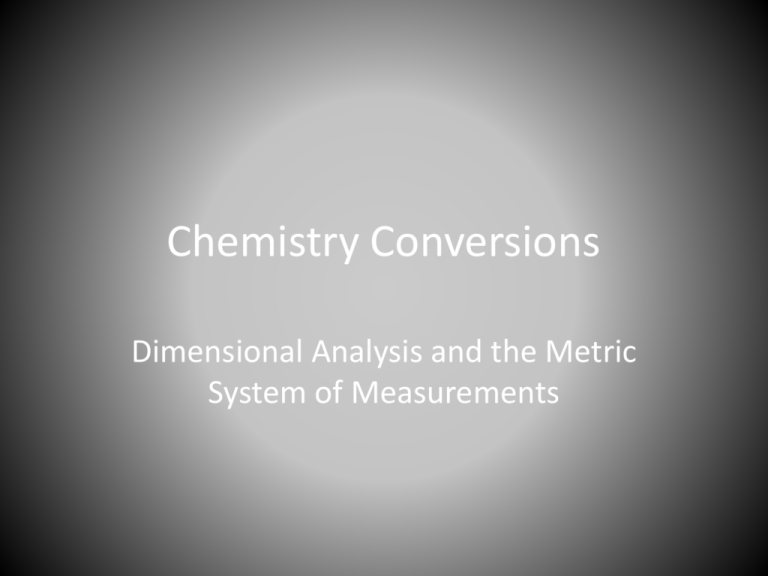Dimensional Analysis (Factor-Label Method) -
advertisement

Chemistry Conversions Dimensional Analysis and the Metric System of Measurements SI Prefixes Prefix Abbreviation Exponential Multiplier Meaning Example using length Kilo- k 103 1000 1 kilometer (km) = 1000 m Hecto- h 102 100 1 hectometer (hm) = 100 m Deka- da 101 10 1 dekameter (dam) = 10 m 100 1 1 meter (m) Deci- d 10-1 1/10 1 decimeter (dm) = 0.1 m Centi- c 10-2 1/100 1 centimeter (cm) = 0.01 m Milli- m 10-3 1/1000 1 millimeter (mm) = 0.001 m Converting From One Unit to Another • We will convert A LOT! • Uses a technique called Factor Label Method • Cancels out units and does the math for you!! Factor-Label Method for Conversions • Mathematics used Numbers, rather than Quantities • Chemistry uses these same Numbers along with the value’s Units • A Number is useless without its unit • Units give the Number an actual meaning Conversion Factors • A conversion Factor is needed to go from one unit to another • You must first know how much of one thing is of another before making any conversions • We all know 1 foot is made up of 12 inches SO… • The conversion factor needed to go from feet to inches or from inches to feet is 1 foot / 12 inches or 12 inches / 1 foot, Some Conversion Factors 1 mile = 1.61 Kilometers 1 inch = 2.54 centimeters 1 gallon = 3.71 Liters • Lets Convert: 157 lbs to kilograms Conversion Factor We May Want To Know: 1 pound = 0.454 Kilograms Conversions 1 pound = 0.454 Kg 157 lb 0.454 kg 1 lb The “Heart” of the problem is where the conversion actually takes place. This is where your conversion factor does its work. Conversions 1 pound = 0.454 Kg 157 lb 0.454 kg 1 lb ( 157 * 0.454 ) / 1 = 71.27 = 71.3 kg So yes, with the proper units 157 lb does equal 71.3 kg, but without units the values are not the same, as we do not know the correct representation numbers. Units • Units are everything. They give any value an actual meaning and interpretation. • Always carry your units through, rewriting them until you reach a final value, or you will be lost. Converting with English Units Question: Convert 15.41 yards to inches: Conversion Factors: • 1 yard = 3 feet • 1 foot = 12 inches Converting with Metric Units Convert 15.41 yards to inches: 15.41 yd Conversion Factors: • 1 yard = 3 feet • 1 foot = 12 inches Converting with Metric Units Convert 15.41 yards to inches: 15.41 yd 3 ft 1 yd Conversion Factors: • 1 yard = 3 feet • 1 foot = 12 inches Converting with Metric Units Convert 15.41 yards to inches: 15.41 yd 3 ft 1 yd Conversion Factors: • 1 yard = 3 feet • 1 foot = 12 inches 12 in. 1 ft Converting with Metric Units Convert 15.41 yards to inches: 15.41 yd 3 ft 1 yd 12 in. 1 ft = (15.41 * 3 * 12) / 1 15.41 yards = 554.8 inches Metric System Common Metric Prefixes: Prefix Abbreviation Value (Base Unit) Kilometer km 1000 Hectometer hm 100 Dekameter dam 10 Base Unit (meter) meter 1 Centimeter cm 0.01 Millimeter mm 0.001 Micrometer µm 0.000001 Converting with Metric Units Question: Convert 0.248 km to centimeters: Conversion Factors: • 1 Kilometer = 1000 meters • 1 meter = 100 centimeters Prefix Abbreviation Value (Base Unit) Kilometer km 1000 Hectometer hm 100 Dekameter dam 10 Base Unit (meter) meter 1 Centimeter cm 0.01 Millimeter mm 0.001 Micrometer µm 0.000001 Converting with Metric Units Covert 0.248 km to centimeters: 0.248 km Conversion Factors: • 1 Kilometer = 1000 meters • 1 meter = 100 centimeters Converting with Metric Units Covert 0.248 km to centimeters: 0.248 km 1000 m 1 km Conversion Factors: • 1 Kilometer = 1000 meters • 1 meter = 100 centimeters Converting with Metric Units Convert 0.248 km to centimeters: 0.248 km 1000 m 1 km 100 cm 1m Conversion Factors: • 1 Kilometer = 1000 meters • 1 meter = 100 centimeters Converting with Metric Units Convert 0.248 km to centimeters: 0.248 km 1000 m 1 km 100 cm 1m = (0.248 * 1000 * 100) / 1 = 24,800 centimeters Much Easier! Calculations: Metric Vs. American System? Prefix Abbreviation Value (Base Unit) Kilometer km 1000 Hectometer hm 100 Dekameter dam 10 Base Unit (meter) meter 1 Centimeter cm 0.01 Millimeter mm 0.001 Micrometer µm 0.000001 Just count the zeros and move the decimal spot to the left or the right.




